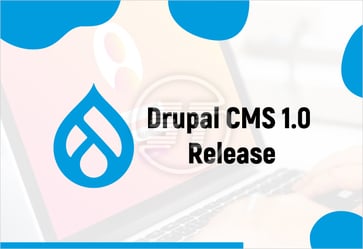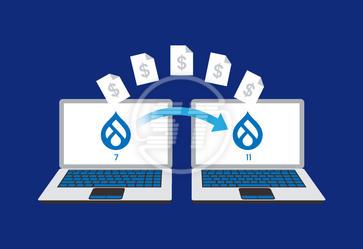Drupal 9 is the new thing! But many are still on Drupal 7, and with the end-of-life getting closer for both Drupal 7 and 8, enterprises are facing a sense of urgency to upgrade their Drupal 7 version to Drupal 8 before migrating to the latest Drupal 9 version. Sticking to older versions is prone to many security challenges.
If you are eager to know how to simplify the entire Drupal migration process, in this comprehensive guide, we are presenting all the details of the process.
YOU MAY ALSO LIKE: Drupal 7 to Drupal 10 Migration
Benefits of Drupal 8 Migration
- To Maintain the Application Security - Drupal 7 is reaching its end-of-life in January 5, 2025 and the applications still on Drupal 7 are prone to security challenges. This is because, after that period, you won’t receive security updates and bug fixes unless you have a long-term support.
- To Migrate to Drupal 9 - Migrating from Drupal 7 to Drupal 8 needs migration of content and configuration while Drupal 8 to Drupal 9 doesn’t need it. So, upgrading to Drupal 8 facilitates a smooth upgrade to Drupal 9 as all the third-party dependencies are updated and deprecated code is removed.
- Easy Content Editing - Drupal 8 facilitates easy content editing experience than Drupal 7. Content editors cannot preview with Drupal 7 but with Drupal 8, you can have quick edits for inline editing, layout builder for changing page layouts, CKEditor WYSIWYG editor for formatting text without using code.
- Deployments Made Easier - Deploying configuration has never been easy and Drupal 8 is a blessing! Earlier one has to go through a painful ordeal of shuffling databases and required contributed modules. With Drupal 8, there is a configuration management system to export site configuration to any files and verify them into a source code folder. You can then import them into instances of the websites, deploy and test them easily.
- Custom-code Refactoring - Drupal’s custom code is difficult and requires a steep learning curve. With Drupal 8, the custom code is refactored to use third-party libraries. For instance, some of the custom code is replaced by the Symfony framework. For dependency management, you can simply use composer rather than downloading core code and contributed modules.
- More Stability - Drupal 8 moves its popular contributed modules into the core to make sure that these important contributed modules aren’t abandoned. You can have a more stable contributor base. Some of the notable ones that are moved into the core are Migrate, views, internationalization, CKEditor, and Bean modules.
- Comprehensive Media Management - Drupal 8 provides effective media management by adding it to the core code so that content editors can create and reuse the media content. One can also embed media into HTML fields for effective media management.
- Drupal Community Made way to Drupal 8 - Drupal community has moved the Migrate module to Drupal 8 core code and included migration scripts to migrate the Drupal 7 configuration to Drupal 8. By migrating to Drupal 8, you can bank on community efforts to migrate your content and data structures with minimal effort.
- More Flexibility with Web Services - Drupal 8 has in-built support to output in any data format other than HTML providing enormous flexibility with Drupal. You can also integrate easily with front-end frameworks like React, Vue.
- Responsive Themes - Drupal 8 has Responsive Image modules for letting Drupal generate and auto-adjust the images on different browsers and devices. It also has Breakpoint module that lets developers make themes and modules aware of the others’ breakpoints. With both these modules, you can build usable and beautiful websites.
Drupal Migration Process
- Website Backup - Before you start your migration process, make sure you have a local copy of your website on your desktop. Even if something goes wrong during the migration process or when it goes live, you can always fall back on the backup copy. This ensures that your data will be safe and intact even if something goes wrong.
- Install Drupal 8 version - Go for Drupal 8.7, the latest Drupal 8 version. You can install the latest Drupal 8 version by downloading it from drupal.org. You can also use composer and install all the dependencies that come along with the latest version.
- Migration Setup - Set up a destination website for your current website to migrate. You can have a local Drupal 8 website on your desktop for this purpose.
- Verify core modules - Make sure your core modules - Migrate, Migrate Drupal, Migrate Drupal UI to be enabled on your new site. You can verify this by navigating to the ‘extend’ tab on the website. When you were upgrading your site to Drupal 7, your old database was automatically upgraded to the Drupal 7 database structure. However, while migrating to Drupal 8, a slightly different approach is followed.
- Upgrade Website Details - You can append the website URL with /upgrade and follow through with a set of instructions to upgrade your website. You can enter the website details like DB location, credentials, and more.
- Start the Migration Process - You can review the summary of upgrade status for all the modules installed on your older site. Carefully review the modules which are not upgraded and you can evaluate if your new website will work without it. If you need any module, you need to install it before proceeding to migrate.
Depending on your website size and the configuration types, the time varies for the entire process to be completed. Once the migration process is completed, you would be automatically directed to the new site’s front page.
Drush Command
There is an alternative method for migrate Drupal 7 to 8 using the Drush command. This is beneficial for migrating complex websites and overcome any roadblocks in the process. Drush would be already present if you are using composer. If not, then you can install using the command ‘composer require drush/drush’. You need to update Drush migrate and enable the contributed modules like Migrate Tools, Migrate Upgrade, Migrate Plus before you start the upgrade process.
Conclusion
The road to Drupal migration is prone to challenges and hence many enterprises dread the process. But upgrading to Drupal 8 is not just the need of the hour but also increases efficiency, security, and overall functionality of the website. While you need to invest in some heavy efforts, the benefits outpace the efforts. You can make up for it through an enriched user experience. If you are considering moving your current website to Drupal 8, now is the time! Our Drupal developers have great experience in developing secure, modular & feature-rich Drupal CMS websites. We provide Drupal migration from Drupal 7 to 8, Drupal 8 to 9 and Drupal 7 to Drupal 9. You can get started by talking to our Drupal developers.


